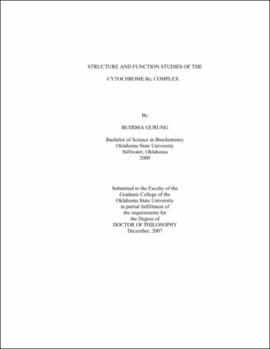| dc.contributor.advisor | Yu, Chang-An | |
| dc.contributor.author | Gurung, Buddha | |
| dc.date.accessioned | 2013-11-26T08:22:53Z | |
| dc.date.available | 2013-11-26T08:22:53Z | |
| dc.date.issued | 2007-12 | |
| dc.identifier.uri | https://hdl.handle.net/11244/6646 | |
| dc.description.abstract | Scope and Method of Study: | |
| dc.description.abstract | The purpose of this study was to gain further insights into the functioning of the bc1 complex based upon data obtained by X-ray crystallography. Cytochrome bc1 complexes from bovine heart mitochondrial were used for our study, and the photosynthetic bacterium Rhodobacter sphaeroides served as the model of choice for our study because of its simplicity, and the ease with which genetic manipulations could be achieved. | |
| dc.description.abstract | Findings and Conclusions: | |
| dc.description.abstract | Besides its involvement in the catalytic cycle of the cytochrome bc1 complex, the Rieske iron-sulfur cluster (ISC) of the iron-sulfur protein (ISP) also acts as a proton exit gate. It prevents the non-specific leakage of protons from the inter-membrane space to the matrix, thereby preventing the collapse of the membrane potential which is eventually utilized by ATP synthase to synthesize ATP from ADP and inorganic phosphate. Incorporation of mutants lacking the ISC into the vesicles along with actively proton-pumping mitochondrial bc1 complex results in the loss of the generated membrane potential. Protons ejected by the functional mitochondrial bc1 complex during electron transfer from ubiquinol to cytochrome c flow back via the mutant complex lacking the ISC. Compartmentalization, a key requisite for establishment of a membrane potential, no longer exists when phospholipid vesicles containing functional bc1 complexes are co-embedded with ISC-lacking bc1 complexes. | |
| dc.description.abstract | Stigmatellin, a Pf inhibitor of the bc1 complex elevates the redox midpoint potential of ISP from +280 mV to +540 mV resulting in the generation of a strong oxidant species. Addition of stigmatellin to completely oxidized bc1 complex leads to reduction of the ISC. Due to the acquired high potential upon stigmatellin binding, the ISC extracts an electron from an organic residue culminating in its reduction and the formation of an organic radical. The radical species can react with molecular oxygen to generate superoxide or donate its electron to cytochrome b resulting in its partial reduction. When ferricyanide is added to the bc1 complex, superoxide generation and slow reduction of cytochrome b is observed, confirming the stigmatellin-induced oxidative nature of the ISC. | |
| dc.format | application/pdf | |
| dc.language | en_US | |
| dc.rights | Copyright is held by the author who has granted the Oklahoma State University Library the non-exclusive right to share this material in its institutional repository. Contact Digital Library Services at lib-dls@okstate.edu or 405-744-9161 for the permission policy on the use, reproduction or distribution of this material. | |
| dc.title | Structure and function studies of the cytochrome bc1 complex | |
| dc.contributor.committeeMember | Yu, Linda | |
| dc.contributor.committeeMember | Soulages, Jose L. | |
| dc.contributor.committeeMember | Burnap, Robert | |
| osu.filename | Gurung_okstate_0664D_2597.pdf | |
| osu.accesstype | Open Access | |
| dc.type.genre | Dissertation | |
| dc.type.material | Text | |
| dc.subject.keywords | bc1 complex | |
| dc.subject.keywords | iron sulfur protein | |
| dc.subject.keywords | proton-pumping | |
| dc.subject.keywords | stigmatellin | |
| dc.subject.keywords | electron transfer complex | |
| thesis.degree.discipline | Biochemistry and Molecular Biology | |
| thesis.degree.grantor | Oklahoma State University | |
